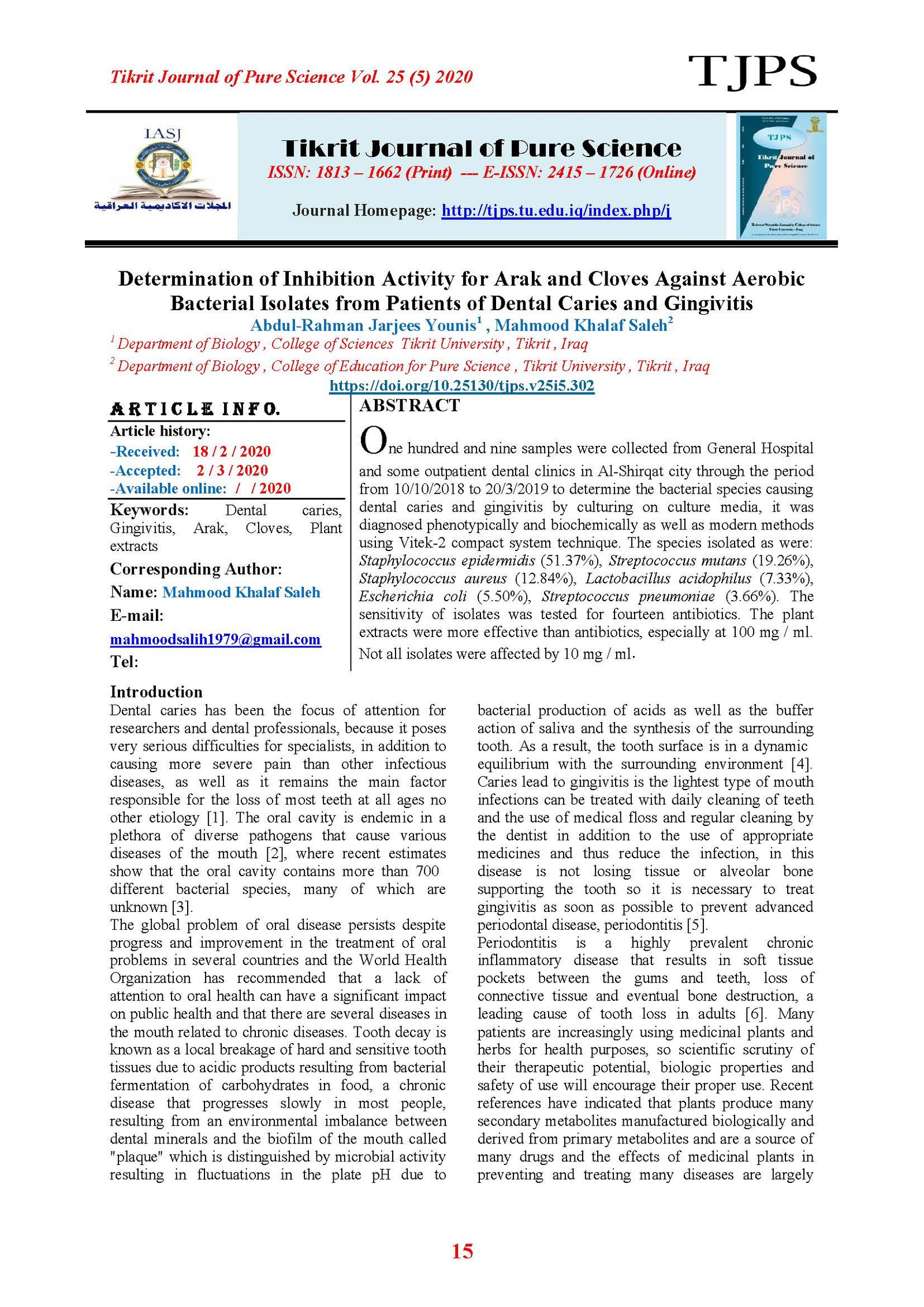Determination of Inhibition Activity for Arak and Cloves Against Aerobic Bacterial Isolates from Patients of Dental Caries and Gingivitis
Main Article Content
Abstract
One hundred and nine samples were collected from General Hospital and some outpatient dental clinics in Al-Shirqat city through the period from 10/10/2018 to 20/3/2019 to determine the bacterial species causing dental caries and gingivitis by culturing on culture media, it was diagnosed phenotypically and biochemically as well as modern methods using Vitek-2 compact system technique. The species isolated as were: Staphylococcus epidermidis (51.37%), Streptococcus mutans (19.26%), Staphylococcus aureus (12.84%), Lactobacillus acidophilus (7.33%), Escherichia coli (5.50%), Streptococcus pneumoniae (3.66%). The sensitivity of isolates was tested for fourteen antibiotics. The plant extracts were more effective than antibiotics, especially at 100 mg / ml. Not all isolates were affected by 10 mg / ml.
Article Details

This work is licensed under a Creative Commons Attribution 4.0 International License.
Tikrit Journal of Pure Science is licensed under the Creative Commons Attribution 4.0 International License, which allows users to copy, create extracts, abstracts, and new works from the article, alter and revise the article, and make commercial use of the article (including reuse and/or resale of the article by commercial entities), provided the user gives appropriate credit (with a link to the formal publication through the relevant DOI), provides a link to the license, indicates if changes were made, and the licensor is not represented as endorsing the use made of the work. The authors hold the copyright for their published work on the Tikrit J. Pure Sci. website, while Tikrit J. Pure Sci. is responsible for appreciate citation of their work, which is released under CC-BY-4.0, enabling the unrestricted use, distribution, and reproduction of an article in any medium, provided that the original work is properly cited.
References
[1] Holt, R.; Robert, G. and Scully, C. (2000). Dental damage, Sequelae, and prevention. B. M. J. 6 (7251): 1717-1720.
[2] El-Desoukey, R.M.A (2015). Comparative Microbiological Study between. The Miswaq )Salvadora persica). Int. J. of Microbiol. Res., 6 (1): 47-53.
[3] Ribeiro, A. A (2016). Biological Features of Dental Caries. JSM Dent.4(3): 1065.
[4] Yadav, Kh and Prakash, S. (2016). Dental Caries: A Review. Asian Journal of Biomedical and Pharmaceutical Sciences, 6 (53), 1-7.
[5] Brijendra, S. and Ritu, S. (2013). Gingivitis - A silent disease. Journal of Dental and Medical Sciences. 6 (5): 30-33.
[6] Shearer, D. (2016). Longitudinal associations between periodontitis and glycated haemoglobin. University of Otago, Dunedin, New Zealand.
[7] Al-Snafi, A. E. (2017). Medicinal plants possessed antioxidant and free radical scavenging effects (part 3)- A review. IOSR Journal of Pharmacy. 7 (4): 48-62.
[8] Tektook, N. K. (2016). The Antibacterial effect of extracts of Salvadora Perscia against oral pathogenic bacteria isolated from dental caries. Al-Kufa University Journal for Biology. 8 (3): 253-263. ISSN: 2311-6544.
[9] Holt, J.G.; Krieg, N.R.; Sneth, P.H.; Staley, J.T. and William, S.T. (1994). "Bergey's Manual of Determinative Bacteriology". 9th ed., Williams & Wilkins company, Baltimore, USA.
[10] Clinical and Laboratory Standards Institute (CLSI). (2014). The performance standard for antimicrobial susceptibility testing; 24th Informational Supplement. 34(1). USA.
[11] Clinical and Laboratory Standards Institute (CLSI), (2011). The performance standard for antimicrobial susceptibility testing; 21st Informational Supplement. 31(1). USA.
[12] Roise, A.C.; Olcea, E. S. and John, A.T. (1987). Method of extraction for plants. American Journal Society. 3:18-25.
[13] Grand, E.T, Sosa, W.R. and Lore, E.R. (1988). Methods of Alcoholic extraction. Botanical Journal. United Kingdom. 5:25-36.
[14] Masahiro, K.; Daisuke, T.; and Shigeru, Y. (2005). CDC guideline based prevention of surgical site infection. The Spine Journal. 5(4):10.
[15] Baron E. J. and Finegold, S. M. (1990). Bailey & Scott's Diagnostic microbiology. 8th ed; The C.V. Mosby Company. Chapter 25:333-352.
[16] Al-Hayali, F. M. and Al-Rassam, Z. Th. and Al-Ani, Y . M. (2012). Investigation of Inhibition of Some Plant Extracts of gram positive and negative Bacteria, Journal of Mesopotamia, 23 (1): 22-38.
[17] Al-Zaidi, F. A. H. (2018). Determination of the inhibitory activity of some plant extracts and toothpastes against some pathogenic bacteria isolated from the oral cavity. PhD. thesis. College of Education for Pure Sciences .University of Tikrit.
[18] Al-Taee, K. T.; Al-Ani, S. S.; Al-Dulaimi, K. K. and Al-Dulaimi, M. M. (2012). Antibacterial activity of crud herbal mixture (Oak bark, Miswak, Cinnamon ,Mint, Clove, Common Camomile and Glycerin oil) on oral pathogenic bacteria . Anb. Med. J. 10 (2): 78-84.
[19] Hassan, A. S. (2012). Effect of aqueous extract of miswak and mouthwash and their interaction on the growth of microorganisms causing gingivitis and dental caries. 23, (7): 19-28.
[20] Al-Dulaimi, A. A. and Al-Azzawi, Z. H. and Al-Khashali, S. Kh. (2011). Effect of Miswak plant extract on Staphylococcus aureus solated from gingivitis patients. Diyala Journal of Pure Sciences. 7(1): 113—122.
[21] Mohammed, S. Gh. (2013). Comparative Study of in vitro Antibacterial Activity of Miswak Extracts and Different Toothpastes. American Journal of Agricultural and Biological Sciences, 8 (1): 82-88.
[22] Al-Bayati, F. A. and Sulaiman, Kh. D. (2008). In vitro Antimicrobial Activity of Salvadora persica L. Extracts Against some Isolated Oral Pathogens in Iraq. Turk. J. Biol. 57-62.
[23] Al-Ayed, M. S. Z.; Asaad, A. M.; Qureshi, M. A.; Attia, H. G., & Al-Marrani, A.H. (2016). Antibacterial Activity of Salvadora persica L (Miswak) Extracts against Multidrug Resistant Bacterial Clinical Isolates. Evidence-Based Complementary and Alternative Medicine. 1-5.
